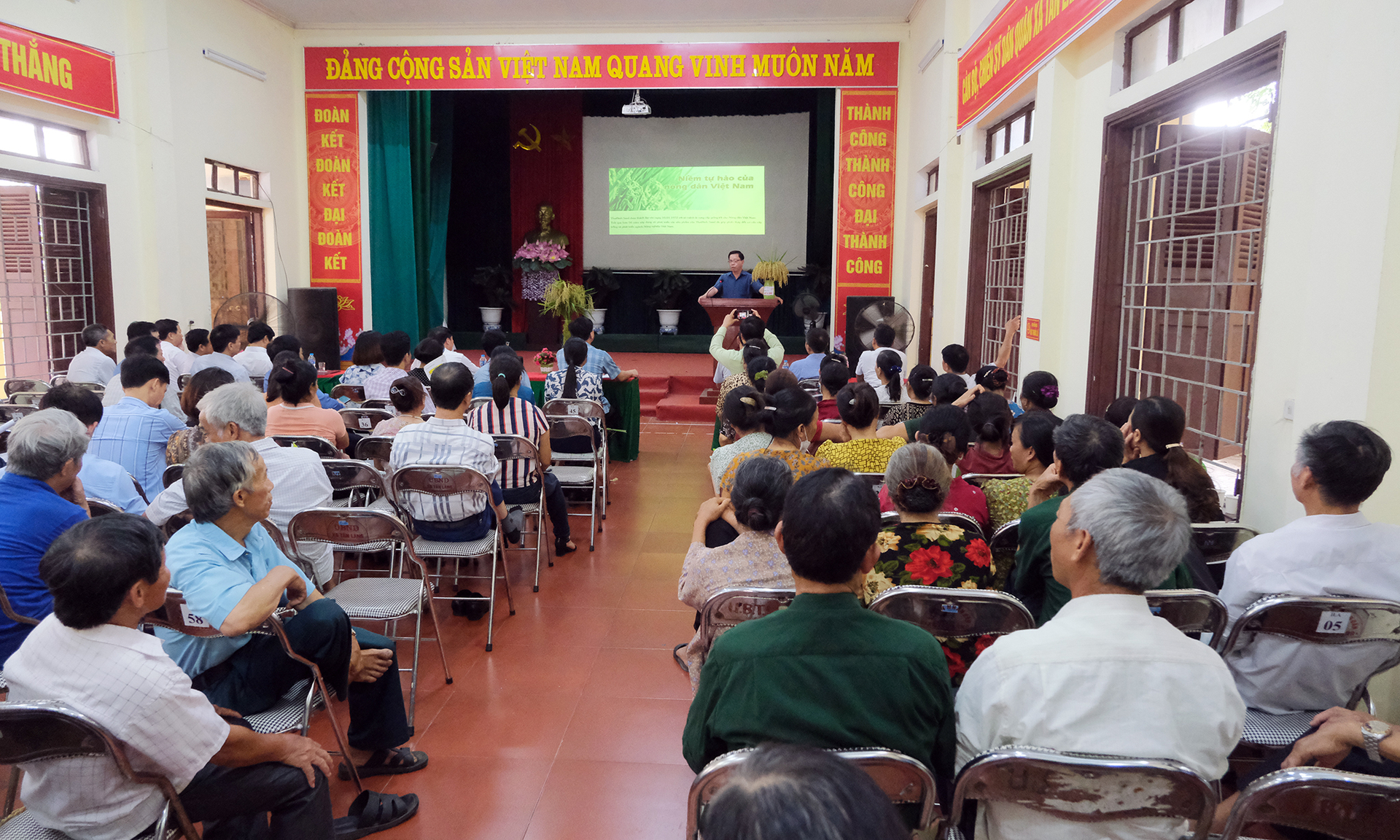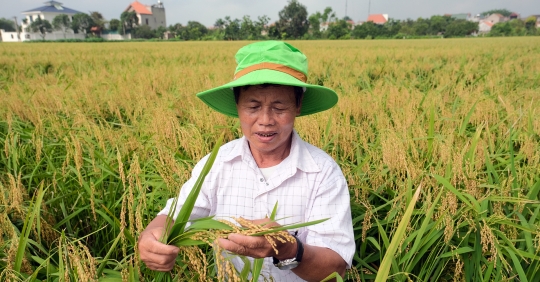A Sao sticky rice
When Mr. Nguyen Ba Van visited the fields in Tam Son Village, Tan Lang Township, Luong Tai District, Bac Ninh Province these days, an indescribable joy overflowed. He boldly tested Thai Binh Seed Group Joint Stock Company’s (ThaiBinh Seed) glutinous rice variety A Sao in more than 9 Sao fields to prepare for harvest. A golden color stretched as far as the eye could see.

Mr. Tran Manh Bao (left), Chairman of ThaiBinh Seed and Deputy Director of Ministry of Agriculture and Rural Development of Bac Ninh Mr. Nguyen Hong Quang visited a glutinous rice field in Sao. Picture: Bao Thang.
Despite being the first crop to be tested barefoot for Kinh Bac, A Sao sticky rice has proven to be suitable and viable. Mr Van shared: “Rice is very resilient, has concentrated flowers and drains well. In particular, A Sao sticky rice is resistant to pests and diseases, which helps reduce fertilizer and pesticide costs.”
Compared with the locally grown traditional glutinous rice variety, the price of A Sao glutinous rice variety is higher, and the cost of purchasing bio-organic fertilizers is also slightly higher in order to improve the soil and be environmentally friendly. Rice, in turn, grows and develops well and is less susceptible to pests and diseases. The yield of A Sao sticky rice was also higher than that of the control variety, about 10 kg/ha.
Mr. Van calculated that with an expected yield of about 2.4 to 2.6 quintals/Sao, including the selling price of two similar glutinous rice varieties, the profit of growing a Sao glutinous rice variety is still about VND 300,000/ha higher.
Mr. Van’s field is in a trial model of about 10 hectares established by Bac Ninh Center for Agricultural Extension and Hi-tech Agricultural Development in cooperation with ThaiBinh Seed in Tan Lang Township, Luong Tai District.

The experimental model of growing A Sao sticky rice in Luong Tai District is about 10 hectares in size. Picture: Bao Thang.
Some distance from Mr. Van’s field, Mr. Tran Van Kha couldn’t hide his smile as he looked at the glutinous rice variety A Sao with large flowers and strong seeds. He said he fell in love with this rice variety from the moment he saw the round, milky white A Sao sticky rice grains, and especially from the moment he enjoyed the soft and delicious cooked sticky rice product.
“I find this strain easy to grow and resistant to pests and diseases. On the other hand, the A Sao glutinous rice variety is bought fresh by the companies, which reduces the labor pressure of post-harvest drying and storage, thus helping to reduce costs. production,” Mr Kha said.
The results in Luong Tai District were even more remarkable when the weather was unfavorable in this year’s winter-spring harvest. The spring harvest temperature this year is 0.5-1°C higher than the average of many years, with a large temperature difference between day and night, accompanied by small rains, drizzles and persistent fog. From February to April. These are favorable conditions for explosive disease to develop and cause damage.
In addition, on May 7-9, the site continues to be affected by late cold air, causing rain with a usual rainfall of 100-120 mm, affecting the ability of pollination and fertilization.

Mr. Nguyen Ba Van in Tam Son Village, Tan Lang Township is excited because the field of 9 Sao of glutinous rice variety A Sao is very free from pests and diseases, the yield is estimated to be more than 2.5 quintals/Sao (360 m2) estimated. Picture: Bao Thang.
Mr. Nguyen Van Dat, an official at the Luong Tai District Agricultural Service Center who was directly involved in providing technical guidance to farmers in this crop, shared, “In the tillering period, the temperature difference between day and night is large. , accompanied by periods of light rain, drizzle and concentrated fog. Blast disease causing damage has occurred in some rice varieties, with a local prevalence of more than 3% of the leaves. However, at that time, the A Sao sticky rice showed no disease.
During the rice standing period, the weather changes, with less rain and humidity, the temperature rises, but there is still a cloudy phenomenon. Based on the experience and close cooperation with ThaiBinh Seed, the district has guided the farmers to take proactive and timely preventive measures when a new blast disease causing 1-3% damage occurs. Second generation leaf rollers show a honey prevalence of 20 animals/m2.
In the period of rice flowering to maturity, the sun and rain alternate, the average temperature is 30 degrees Celsius, the day-night difference is large, creating favorable conditions for cottonneck disease damage, especially in the infected areas with blast. Leaves. But compared to local traditional varieties, A Sao sticky rice has a 3-5% lower blast infection rate.
The area specializing in glutinous rice cultivation “nods” to A Sao
On June 1, ThaiBinh Seed, in cooperation with Bac Ninh Center for Agricultural Extension and High-Tech Agricultural Development, organized a workshop to evaluate the production results of A Sao glutinous rice variety in Tan Lang Township (Luong Tai District). Mr. Tran Minh Chau, Director of Hanoi Branch (belonging to ThaiBinh Seed Group), said that A Sao glutinous rice is a kind of glutinous rice that can be cultivated for both crops per year.
The growing season is 125-135 days for spring harvest and 105-110 days for harvest; tree height 120 – 130cm; Beautiful shape, strong branches, large flowers, round seeds, 1,000 seeds weigh 23-25 g.

When harvested from 25 clusters in an area of 1 m² of the demonstration field, the fresh rice weight reached 1.17 kg. Picture: Bao Thang.
A Sao sticky rice is quite cold hardy and easily affected by leaf blight and powdery mildew as well as blast disease when encountering unfavorable weather conditions. The average yield is 46-52 quintals/ha, with good intensive farming 55-60 quintals/ha.
Seedlings grow well and are hardy. At the age of 24-25 days, the number of leaves is 3-4 true leaves, and the height is 17-18 cm. Rice in the model is planted in concentrated form at a density of 25-30 bunches/m2. At the end of tillering, the rice plant is 120–125 cm tall and has 8–12 branches.
Throughout the production process, ThaiBinh Seed continuously organizes training and process transfer to help people participate in the model and understand the techniques of A Sao sticky rice production. At the same time, households should be promoted to engage in the concentrated planting model in areas that allow for convenient monitoring, tending, and harvesting.
At the field workshop on June 1st, the field owners participating in the model directly harvested rice to evaluate the efficiency. From 25 clusters on about 1 m² demonstration field, the amount of fresh rice reached 1.17 kg. This result ensured that many people could not help but admire and excite it.
Based on the results obtained, the Luong Tai District Agricultural Service Center concluded that the A Sao glutinous rice variety is suitable for the soil conditions as well as the agricultural practices of the local people and contributes to enriching the range of varieties in the district where glutinous rice is traditionally cultivated.

Hundreds of farmers attended the workshop to evaluate the production results of the A Sao glutinous rice variety on June 1. Picture: Bao Thang.
Mr. Nguyen Hong Quang, deputy director of the Bac Ninh Ministry of Agriculture and Rural Development, said ThaiBinh seed currently accounts for more than 30% of the province’s rice seed structure. The successful first trial of A Sao sticky rice variety helps people choose more suitable seed sources for production. At the same time, the planning of concentrated raw material production areas is promoted, bringing great economic value to people.
“The search for new varieties of rice with high yield, high quality and resistance to pests and diseases contributes to the achievement of goals set by the province’s agricultural sector, including the increased use of high technology in production,” said Mr. Quang.
The development and imitation of rice production models like the ThaiBinh Seed implemented in Luong Tai District also bodes well for the connection between enterprises, people and cooperatives, and lays a favorable foundation for chain building. value later.
At the workshop on June 1st, representatives of the Ministry of Agriculture and Rural Development of Gia Binh District and Luong Tai (Bac Ninh) District were impressed by the A Sao glutinous rice variety. For the upcoming harvest, Gia Binh promises to research, examine and test ThaiBinh Seed’s strains to expand the planting area.

